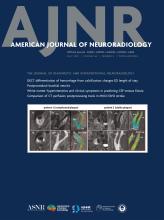This article requires a subscription to view the full text. If you have a subscription you may use the login form below to view the article. Access to this article can also be purchased.
Graphical Abstract
Abstract
BACKGROUND AND PURPOSE: Ruptured PICA aneurysms present considerable treatment challenges due to their rarity and proximity to critical neurovascular structures. This study aims to report and critically analyze the long-term neurologic outcomes of patients with ruptured PICA aneurysms treated at our tertiary center and to evaluate the prognostic value of prepontine cistern filling grade on initial CT scans.
MATERIALS AND METHODS: Clinical and radiologic data were retrospectively collected for consecutive patients with ruptured PICA aneurysms treated at our institution between January 2010 and December 2021. The prepontine cistern filling was graded from 0–3 on sagittal slices of the initial CT scan by 2 independent readers.
RESULTS: Fifty-seven patients with ruptured PICA aneurysms were included. The mean aneurysm diameter was 7.2 mm (SD ± 4.9), with a mean radiologic follow-up of 40.2 months (SD ± 45.2). Endovascular treatment was the primary technique (96.5%), with a small number (3.5%) requiring microsurgical clipping. Parent vessel sacrifice was performed in 49% of cases. Complete aneurysm occlusion was achieved in 79% of patients, with a recurrence rate of 19%. External ventricular drainage was necessary in 83% of patients, and 28% later required a permanent ventricular shunt. Symptomatic vasospasm occurred in 37% of patients. The in-hospital mortality rate was 11%, and 55% of survivors required a transient tracheostomy. At 1-year posthemorrhage, 60% had a good neurologic outcome. Multivariate analysis revealed that poor neurologic outcomes were significantly associated with higher grade of prepontine cistern filling (P < .05) and in those whose parent vessel had to be sacrificed (P < .05).
CONCLUSIONS: Ruptured PICA aneurysms carry a grim prognosis and pose major management challenges. Both the grade of prepontine cistern filling on initial CT scan and the need for parent vessel sacrifice are important prognostic factors.
ABBREVIATIONS:
- GCS
- Glasgow Coma Scale
- IQR
- interquartile range
- WFNS
- World Federation of Neurosurgical Societies
- © 2025 by American Journal of Neuroradiology













